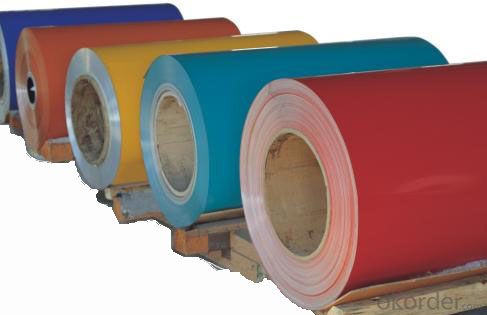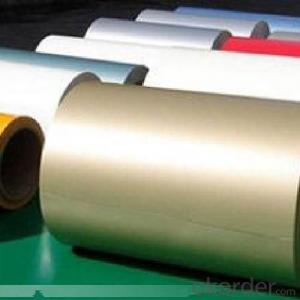Aluminum Sheets Indiana - Prepainted Aluminum Coils Polyester Coating AA3003
- Loading Port:
- Shanghai
- Payment Terms:
- TT OR LC
- Min Order Qty:
- 5 m.t.
- Supply Capability:
- 60000 m.t./month
OKorder Service Pledge
OKorder Financial Service
You Might Also Like
Specification
1.Structure of Prepainted Aluminium Coils
PE Coated aluminium coils are widly used in decoration field. For the painting, it depends on the using evironment. If you use in the open air, we recommend the PVDF coated aluminium coils. This kind of painting can last 15-20 years. If you use in the room, we recommend PE coated aluminium coils. The price is much more competitive.
2. Main features of Prepainted Aluminium Coils
a.Competitive price---We have our own mills and can produce mill finished aluminium coils, so we can control the production cost better.
b.Professional after-sale service---We have more than 15 years exportation experience and you need not worry about the exporation problems.
c.Fast delivery time---We can control the delivery time within 35 days.
3. Image



4. Product Specification
| ALLOY | Temper | Thickness | Width | Weight |
| AA3003 | H14 | 0.2mm-3mm | 1200MM-1800MM | Min 5 tons |
5.FAQ:
What is the quality standard?
---Usually our standard is GB3880-2006
What is the largest width?
---It is 2300mm
What is the MOQ?
---Usually we can accept 80 tons.
- Q: Can aluminum sheets be used for cookware?
- Cookware can indeed utilize aluminum sheets. Due to its exceptional heat conductivity and lightweight nature, aluminum remains a favored material for cookware. In the construction of cooking utensils like pots, pans, and baking sheets, aluminum sheets frequently serve as the base or core material. To enhance durability and user-friendliness, these sheets are often coated with a nonstick or ceramic layer. Nonetheless, it is crucial to recognize that pure aluminum can react with certain acidic or alkaline foods, resulting in a metallic taste or discoloration. To prevent such occurrences, most aluminum cookware is anodized or coated, establishing a barrier between the food and the aluminum surface. All in all, aluminum sheets prove to be an adaptable and widely employed option for cookware in both professional and domestic kitchens.
- Q: What are the different surface finishes for aluminum sheets in the construction industry?
- In the construction industry, there are several different surface finishes that can be applied to aluminum sheets. These finishes are designed to enhance the appearance and durability of the aluminum, making it suitable for various construction applications. One common surface finish for aluminum sheets is mill finish. This finish is the raw, untreated surface of the aluminum, which may have some minor imperfections or scratches. Mill finish is often used in applications where appearance is not a major concern, such as structural components or industrial projects. Another popular surface finish is anodized finish. Anodizing is an electrochemical process that creates a protective layer on the surface of the aluminum, making it more resistant to corrosion and wear. Anodized finishes can come in a variety of colors, allowing for greater design flexibility in construction projects. This finish is commonly used for architectural elements, such as window frames, facades, and decorative panels. Painted finishes are also commonly used in the construction industry. Aluminum sheets can be coated with a layer of paint, which provides both aesthetic appeal and additional protection against corrosion. Painted finishes can be customized to match specific design requirements, making them suitable for a wide range of construction applications. Additionally, brushed finishes are often used in the construction industry. Brushing is a mechanical process that creates a textured surface on the aluminum, resulting in a distinctive, matte appearance. This finish is commonly used for decorative purposes, such as interior wall panels or furniture in commercial spaces. In summary, the construction industry offers a variety of surface finishes for aluminum sheets. These finishes include mill finish, anodized finish, painted finish, and brushed finish. Each finish has its own unique properties and benefits, allowing for greater versatility and customization in construction projects.
- Q: What are the different methods of joining aluminum sheets without welding?
- There are several methods of joining aluminum sheets without welding, including adhesive bonding, mechanical fastening (such as screws or rivets), clinching, and using non-welding techniques like friction stir welding or laser welding.
- Q: Are aluminum sheets suitable for elevator interiors?
- Yes, aluminum sheets are suitable for elevator interiors. Aluminum is a durable and lightweight material that is resistant to corrosion, making it ideal for use in elevator interiors. It can be easily customized and offers a sleek and modern aesthetic. Additionally, aluminum is easy to clean and maintain, making it a practical choice for elevator interiors.
- Q: There seems to be a load of buzz out there regarding the use of aluminum pots and pans. They apparently may cause Alzheimer’s or bone degeneration in women. I have some cast iron pans that I use when ever possible but they are not always practical. I’d like some of you kitchen pros to give me some sound advice regard the use of aluminum in the home kitchen. I know they are used in food service organizations.... I look forward to some informative replys.Thanks in advance.
- Your right it's like if you drink alot of soda or beer out of aluminum yes it's a fact that evetually it can cause health issues,i know i apologize for my spelling and it sucks.
- Q: What are the potential safety issues that may arise from the use of aluminum sheets?
- <p>Aluminum sheets are generally safe to use in most applications. However, there are a few safety concerns to consider. First, aluminum can be a skin irritant for some individuals, so it's important to wear protective gloves when handling. Second, aluminum dust, when inhaled, can cause respiratory issues. Proper ventilation should be maintained during cutting or grinding operations. Lastly, aluminum can conduct electricity, so it should not be used in electrical applications without proper insulation. Always follow safety guidelines and use protective equipment when working with aluminum sheets to minimize these risks.</p>
- Q: What is the typical corrosion resistance of aluminum sheets?
- Aluminum sheets possess a remarkably high level of corrosion resistance. They naturally generate a protective oxide layer on their surface, which effectively thwarts any further corrosion. This layer of oxide acts as a formidable barrier, preventing moisture and other corrosive elements from accessing the underlying metal. Moreover, aluminum exhibits exceptional resistance to numerous prevalent forms of corrosion, including rusting and pitting. Nonetheless, the corrosion resistance of aluminum can fluctuate depending on several factors, such as the composition of the alloy, the treatment applied to the surface, and exposure to harsh environments. In general, aluminum sheets are renowned for their impressive ability to resist corrosion, rendering them suitable for a vast array of applications across various industries.
- Q: How does the thickness of aluminum sheet affect its strength?
- The thickness of an aluminum sheet directly affects its strength. In general, a thicker sheet of aluminum will be stronger than a thinner one. This is because the thickness of the sheet determines the amount of material present, which in turn affects the sheet's ability to withstand external forces or loads. The strength of a material is typically measured by its ability to resist deformation or failure under stress. Thicker aluminum sheets have a greater volume of material, which means there are more atoms and bonds available to withstand forces. This results in a higher resistance to deformation or failure, making the sheet stronger. Additionally, a thicker aluminum sheet also has a higher load-bearing capacity. This means it can support heavier loads or withstand higher pressures without deforming or failing. The increased thickness provides more material to distribute the load, reducing the stress on individual atoms and bonds within the sheet. However, it is important to note that there is a limit to the thickness at which the strength of the aluminum sheet plateaus. Beyond a certain point, further increasing the thickness may not significantly improve its strength. This is because the material properties of aluminum, such as its crystal structure and grain boundaries, also play a role in determining its strength. In conclusion, the thickness of an aluminum sheet directly affects its strength. Thicker sheets have more material, enabling them to resist deformation or failure under stress more effectively. This increased thickness also allows them to support heavier loads or withstand higher pressures. However, there is a limit to the thickness at which the strength plateaus, as other material properties come into play.
- Q: This question asks for signs or indicators that would suggest whether a roof needs to be replaced or repaired using aluminum sheets.
- <p>To determine if your roof needs replacement or repair with aluminum sheets, look for the following signs: visible rust or corrosion, especially on the seams and fasteners; sagging or buckling in the roof surface; leaks or water damage inside your home; and excessive noise during rain or wind. If the damage is widespread or the roof is old, replacement might be necessary. However, if the damage is limited to specific areas, repairs could suffice. It's always best to consult with a professional roofer for an accurate assessment.</p>
- Q: What are the different types of surface treatments available for powder-coated aluminum sheets?
- Some different types of surface treatments available for powder-coated aluminum sheets include anodizing, chemical etching, mechanical polishing, and electroplating. Each treatment offers unique benefits and can enhance the appearance, durability, and corrosion resistance of the aluminum sheets.
Send your message to us
Aluminum Sheets Indiana - Prepainted Aluminum Coils Polyester Coating AA3003
- Loading Port:
- Shanghai
- Payment Terms:
- TT OR LC
- Min Order Qty:
- 5 m.t.
- Supply Capability:
- 60000 m.t./month
OKorder Service Pledge
OKorder Financial Service
Similar products
Hot products
Hot Searches
Related keywords




























